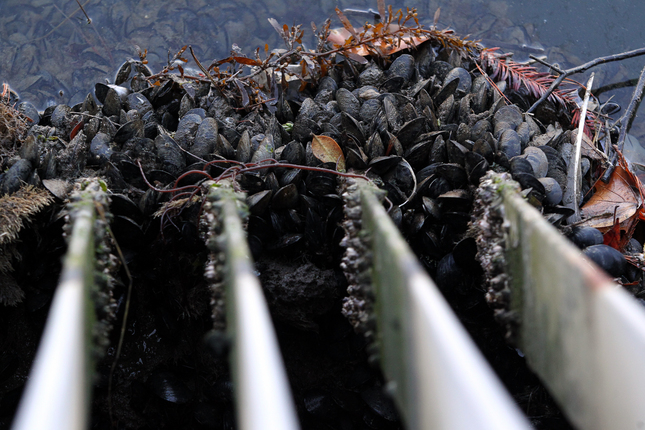November 7, 2014 There is hope after all! A terrific piece by Matt O’Brien in the Oakland Tribune describes the return of marine life to Lake Merritt (an estuary that White Man cut off from San Francisco Bay and defined as a lake). Some water has been flowing back in since 2012, thanks to a voter-approved beautification project. There are now so many shellfish clogging the grates at the pump station that divers have to clear them twice a year. The divers are led by Dave Buller, who has been working in Lake Merritt since the 1980s (when he saw only one life form: tube worms). Alameda County is paying the divers $67,000 for a job expected to take 17 days. Doesn’t that seem like a low price for difficult labor? You hear about architectural firms getting half a million to plan an on-ramp… Take it away, Matt:
OAKLAND — Sea squirts, bat rays, mollusks and monstrous-looking sea spiders are having a feast in the depths of Lake Merritt.
The teeming aquatic wildlife signals the improving health of Oakland’s urban jewel, but some of the creatures are also clogging a 40-year-old pump station that protects downtown and lakeside neighborhoods from flooding.
An emergency dive team on Wednesday and Thursday dropped into the channel that connects Lake Merritt to the Oakland Inner Harbor and San Francisco Bay, scraping off hordes of bay mussels, barnacles and even some oysters that have latched on to the pump station’s trash racks.

Mussels, barnacles and other marine growth clog the grates at the Lake Merritt Flood Control Facility pump station on the West end of the lake in Oakland, Calif., Thursday, Nov. 6, 2014. Alameda County public works has hired a commercial dive team for an emergency job to clear the pumps before the rainy season. (Anda Chu/Bay Area News Group)
“The good news about oysters is it’s a sign the quality of water has vastly improved,” said dive team leader Dave Buller. “The bad news is they’re extremely difficult to remove.”
On Wednesday, as the city’s new Mayor-elect Libby Schaaf was celebrating her electoral victory at the Lake Merritt Amphitheater by riding a fire-breathing art car shaped like a snail, diver Chris DeLauter was swimming downstream and finding real mollusks and other marine life as bizarre-looking as Schaaf’s metal chariot.
Coots, cormorants and grebes sailed on the surface of the tidal channel that courses through the Laney College campus as DeLauter bubbled underneath, chattering through a radio system to Buller and their tender, Tony Rayford.
A county dive inspector probed the channel late last month and declared an emergency. The Alameda County Public Works Agency responded this week by hiring the commercial divers from Coastal Diving for a 17-day, $67,000 job to clean the pump station’s underwater trash racks and bubbler tubes.
Buller, the team leader, said he has been diving into the channel to do similar work since the 1980s.
“I remember the first time I dropped down in the water, there was only one species of marine life: tube worms,” he said.
Among his other finds in the channel deep over the years: Century-old beer bottle caps from the city’s brewery heyday. Handguns, ammunition and a forest of sawed-off parking meters raided of their coins. Candles and other objects from unauthorized floating funeral ceremonies. And dead freshwater turtles abandoned by pet owners who might not have realized they would quickly die in the brackish waters.
The county typically cleans the pump racks each fall ahead of the rainy season but now is contemplating twice-a-year cleanups because of the increasing marine growth, said Gene Mazza, the pump station supervisor.
“It is a lot more than we’ve gotten in the past. It tells us that the water quality is vibrant,” Mazza said.
The likely reason for that vibrancy is a project completed last year reverting Lake Merritt to some of its natural splendor as a thriving estuary. The voter-approved beautification project removed box culverts under 12th Street and allowed water to flow more freely through the channel.
Lake Merritt was a saltwater tidal lagoon before city leaders dammed it up and called it a lake in the late 19th century, eliminating marshes and mud flats, depleting oxygen, killing off fish and other wildlife, and leading to mounting flood dangers by blocking the natural flushing of water out to the bay.
The worst flood came in October 1962, when heavy rains and high tide combined to unleash waters into neighborhoods encircling the lake. Photographs inside the pump station show the busy intersection of Lakeshore Avenue and East 18th Street nearly 7 feet underwater.
Flood control officials responded by building a pump station, which is reached by an elevator from the Seventh Street Bridge. The station still serves a critical purpose in flood prevention, said pump engineer Tom Tidwell on a tour beneath the bridge Wednesday, but the blooming wildlife has become harder to clear from the machinery.
“You increase the tidal current, you increase the food supply,” Buller said.
Gondolas, canoes and crew boats already ply Lake Merritt. Buller said civic leaders should soon consider another kind of vessel.
“In a few years there may be a glass-bottom boat,” he said. “The different degrees of color in the sponges are spectacular. They range from bright red to orange, orange-red, browns and tans, and off-white. Few residents know what kind of diversity of life they have down there.”





